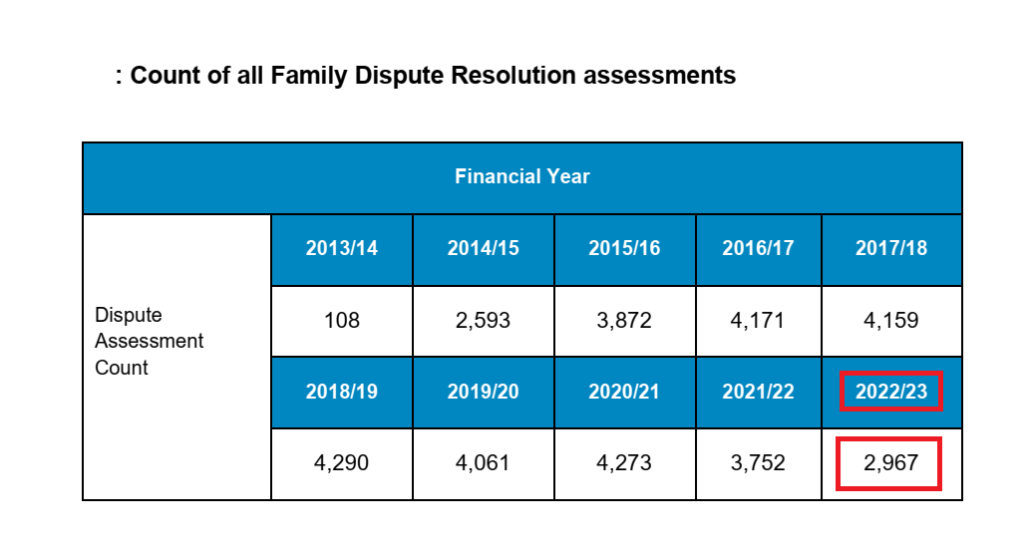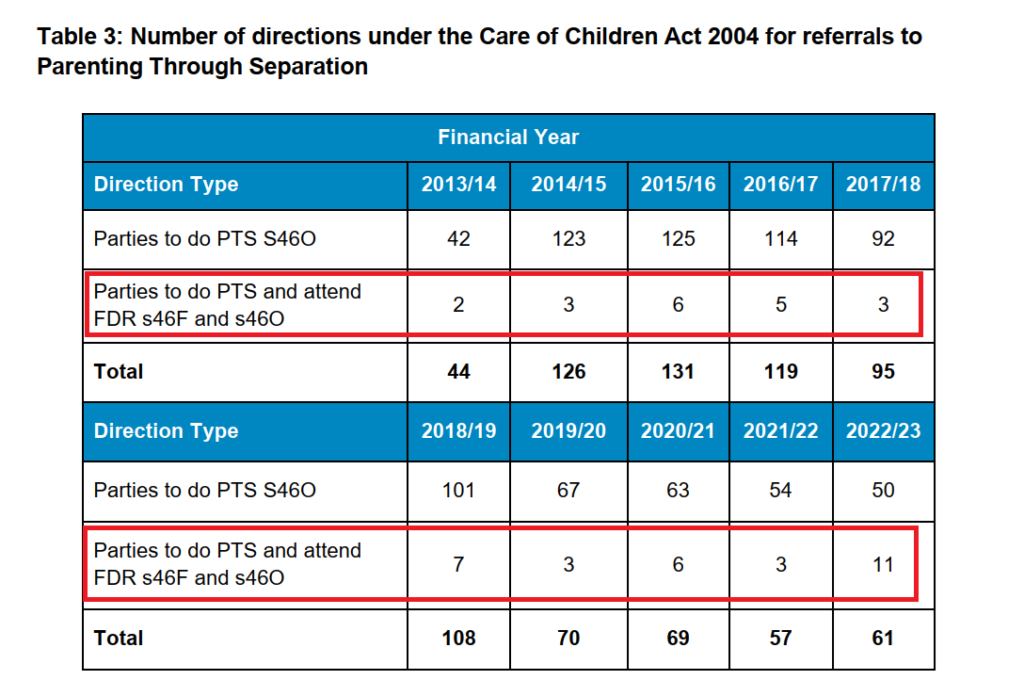In the complex arena of family separation, navigating disputes can be an overwhelming experience. The latest statistics for 2022/2023 reveal a significant disparity between the number of applications processed through the Family Court under the Care of Children Act (CoCA) and those resolved through Family Dispute Resolution (FDR) aka (Family Mediation). With a staggering 16,603 CoCA applications filed and only 2,967 FDR assessments conducted, it becomes clear that nearly 80% of family-related disputes are opting for formal litigation rather than FDR mediation.
Statistics were obtained from the Ministry of Justice as below:
Table 1 below: 2,967 FDR assessments conducted in 2022/2023

Table 2 below: Nearly 16,603 Care of Children applications filed in 2022/2023

(Table 3 below) –Section 46F of the Care of Children Act 2004 (added in 2013) empowers Family Court Judges to direct parties to Family Dispute Resolution (FDR) if appropriate, after the commencement of court proceedings. However, between 2013 and 2023, only an average of five cases per year were directed to FDR. These figures are notably low.

Understanding the statistics:
To put things into perspective, Family Dispute Resolution (FDR), also known as mediation, currently handles only about 20% of the total cases entering the Family Court system. Some of these cases achieve resolution through FDR, while others do not. Additionally, some parents bypass FDR altogether by filing applications on the “without notice” track.
This raises important questions about why so many families are choosing the litigation route, which can be time-consuming, costly, and emotionally taxing.
Factors Contributing to the Disparity
Several key factors may help explain this trend:
1. Lack of Awareness:
Many individuals may not be fully informed about FDR or the potential benefits it offers. Mediation often leads to quicker, more amicable resolutions, but if people aren’t aware of these options, they naturally lean towards the more traditional court process.
2. Lack of Promotion in the Family Court:
Although Section 46F of the Care of Children Act 2004 empowers judges to refer parties to mediation, FDR is not being emphasized as much as it could be. The court may not be consistently highlighting FDR, leaving many parties unaware that mediation is a viable option. (Refer to Table 3 for more details.)
3. Misuse of the court process: The court process can be easily misused for wrongful purposes such as retaining the children fulltime or the property or vindictiveness… etc. There is no current filtering criteria for filing applications in the Family Court.
4. Complex Nature of Disputes:
Family disputes can be deeply complex, involving emotional and relational issues that make mediation challenging. When tensions are high, parties may feel more secure relying on the authority of the court to resolve their issues.
5. Legal Representation:
The belief that legal representation is essential in court proceedings can discourage families from considering mediation. Many feel that navigating disputes without a lawyer could leave them vulnerable or disadvantaged.
6. Perceptions of Fairness:
There may be a perception that the Family Court provides a more structured and equitable process. If one party doubts the other’s willingness to negotiate fairly, they may view court proceedings as the more reliable option.
7. Urgency:
Some disputes require immediate attention. Families facing urgent issues may opt for litigation instead of waiting for mediation sessions to be scheduled.
8. Court Mandates:
In certain jurisdictions, specific cases must proceed through litigation, limiting opportunities for FDR even when mediation could be appropriate.
The Path Forward:
Addressing this disparity is crucial for creating a more efficient family justice system. Here are several steps that could help bridge the gap:
1. Enhancing Public Awareness:
Educational campaigns that inform families about the benefits of mediation can empower them to consider FDR as a viable option. Workshops, community seminars, and online resources could play a significant role in raising awareness.
2. Improving Accessibility:
Making mediation services more accessible, including offering financial assistance for low-income families, can enable more people to benefit from FDR.
3. Integrating FDR into the Court Process:
Courts can encourage mediation by mandating FDR as a preliminary step before litigation in certain cases. This could help families explore amicable resolutions before the pressures of court come into play.
4. Training and Support:
Offering better training for mediators and providing support to families navigating the FDR process could enhance the effectiveness and appeal of mediation as an option.
Conclusion:
The significant gap between Family Court applications and FDR assessments highlights the need for systemic change within the family justice system. By promoting a greater understanding of mediation, improving access to FDR, and integrating mediation more seamlessly into court processes, families can navigate disputes more amicably and efficiently. Ultimately, empowering families to choose resolution methods that best suit their needs will lead to healthier outcomes for all involved. Let’s bridge this gap and move towards a more balanced approach to resolving family disputes.





